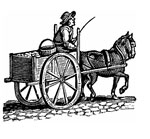
The Technological Society: Where What’s Artificial Seems Natural
THE AMISH VS. THE DEPOPULATION BOMB
My family and I had just left my sister-in-law’s place in Norwich, Connecticut, and I found myself perusing a tourist magazine titled Discover Connecticut. What absorbed me most, as I thumbed backwards through the articles on historic tours, restored downtown areas, and forest preserves, were the photographs of magnificent real estate for sale in the Connecticut countryside at prices I knew I could never afford. And then I got to the “editorial page.” The title, a bit incongruously, said something about “sex education.” Paragraph after paragraph of blithe advocacy it was, exalting the need for new and expanded information, the more explicit and thoroughgoing the better, enlightening all grammar school children down to kindergarten on the necessity of, and deft use of paraphernalia for, sterile sexual intercourse.
The author, a short biography related, is a registered nurse; never once during her piece did she betray the awareness that anyone might possibly have the tiniest reservation about her recommendations. Question Progress? The feeling I got, indeed, was remarkably similar to the impression I receive when scanning our society’s approach to technology in general, the imperative underlying the seemingly unstoppable technical progression of the last 200 years: “Anything that can be done, will be done.” Another way to put this is that improved artificial means of contraception, like television, automobiles, and computers, are seen as entitlements — not as substances rife with potential danger, but as naturally and rightfully ours, and as limitlessly usable and unquestionably salutary as the air we breathe, and that whatever side effects they may bring can be managed by further applications of technology or technique. Jocelyn Elders, President Clinton’s Surgeon General, summed the sentiment up quite bluntly: “We’ve taught our children in driver’s education what to do in the front seat, and now we’ve got to teach them what to do in the back seat.” It is interesting to note the automobile’s role as precursor in this seemingly inexorable development.
Soon we arrived back home from our trip (admittedly by automobile) to our small farm, in proximity to a thriving Old Order Amish community, whose households, bustling with eight or more children per family, flout the American status quo. The ban on contraceptives is one of many Amish technological restrictions — e.g., on cars, electricity, and, in this particular enclave, all motors. (The term “Amish” here encompasses both Old Order Amish and Old Order Mennonite groups, which share many similar restrictions regarding technology.)
Is it a coincidence that Elders linked the car with the condom? Or that in Amish society a ban on one goes along with a ban on the other? Artificial contraception is often seen as a cause (of sexual promiscuity, weakening of the marital bond, and a host of derived sociological problems), less often as an effect. Those who would focus all attention on the Pill or the condom risk treating the symptoms and not the deeper disease. Unfortunately, Catholic social teaching seems to address the contraception problem in isolation and not link it to antecedent technical and social developments that may have paved the way for it. The result has seemed as artificial as the Pill itself, a kind of “grit your teeth and bear it” approach, that ignores deeper structural factors.
You May Also Enjoy
The modcon Our Sunday Visitor is now advocating a new vaccine for a sexually transmitted disease given to girls at age 11.
Like Oedipus, we humans are prone to suppose that we can understand all things on earth — perhaps in heaven also — and can thereby control them.
Tolstoy was a world-class novelist and a great and influential heretic: His avant-garde views heralded today’s liberal and relativistic Christians.

